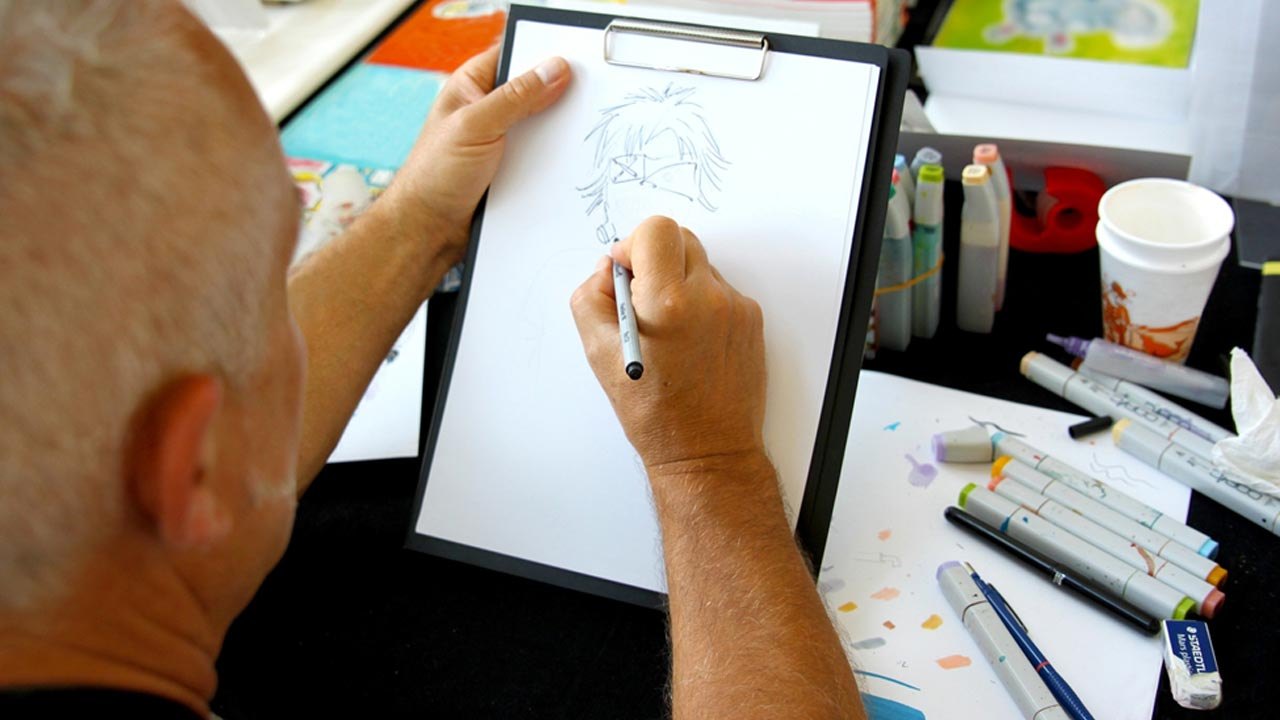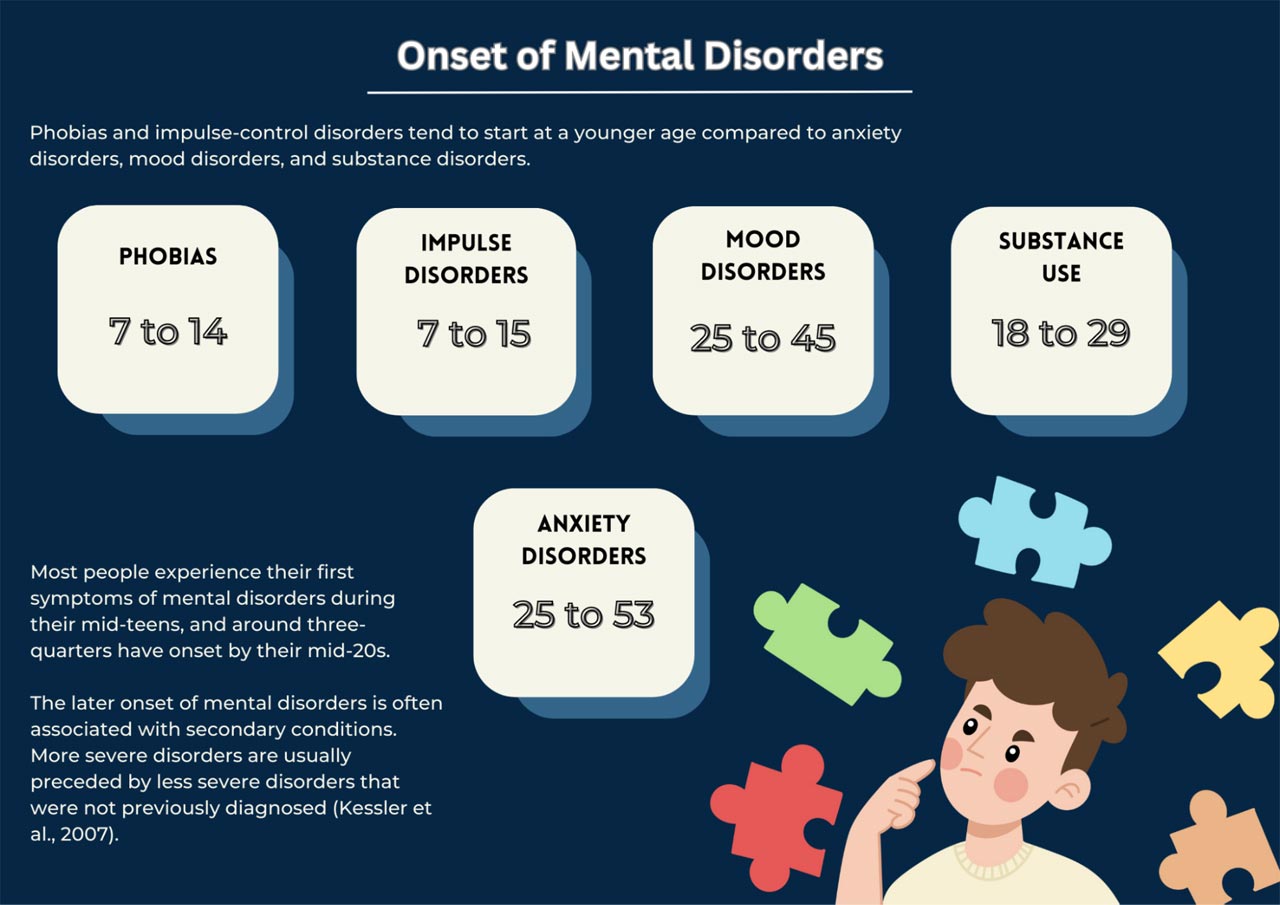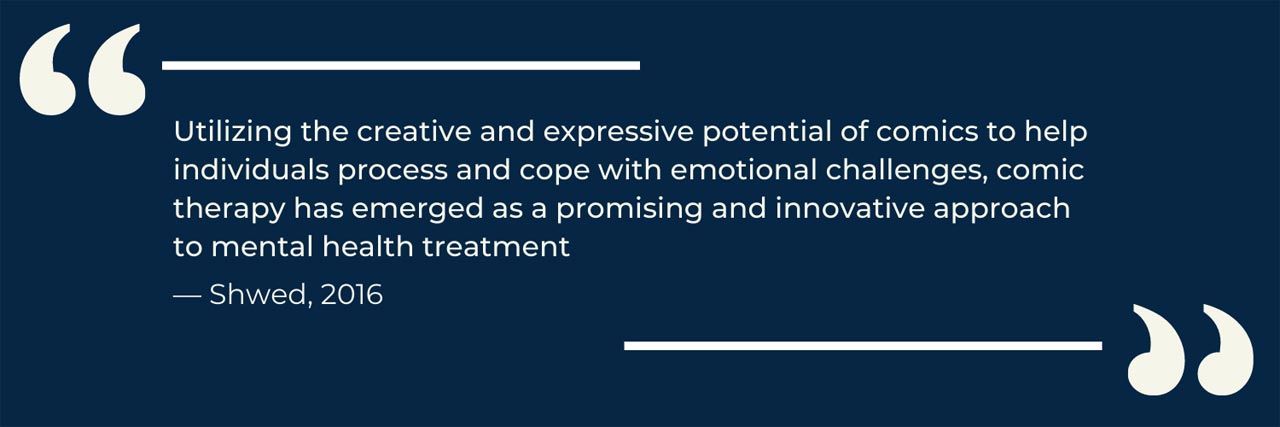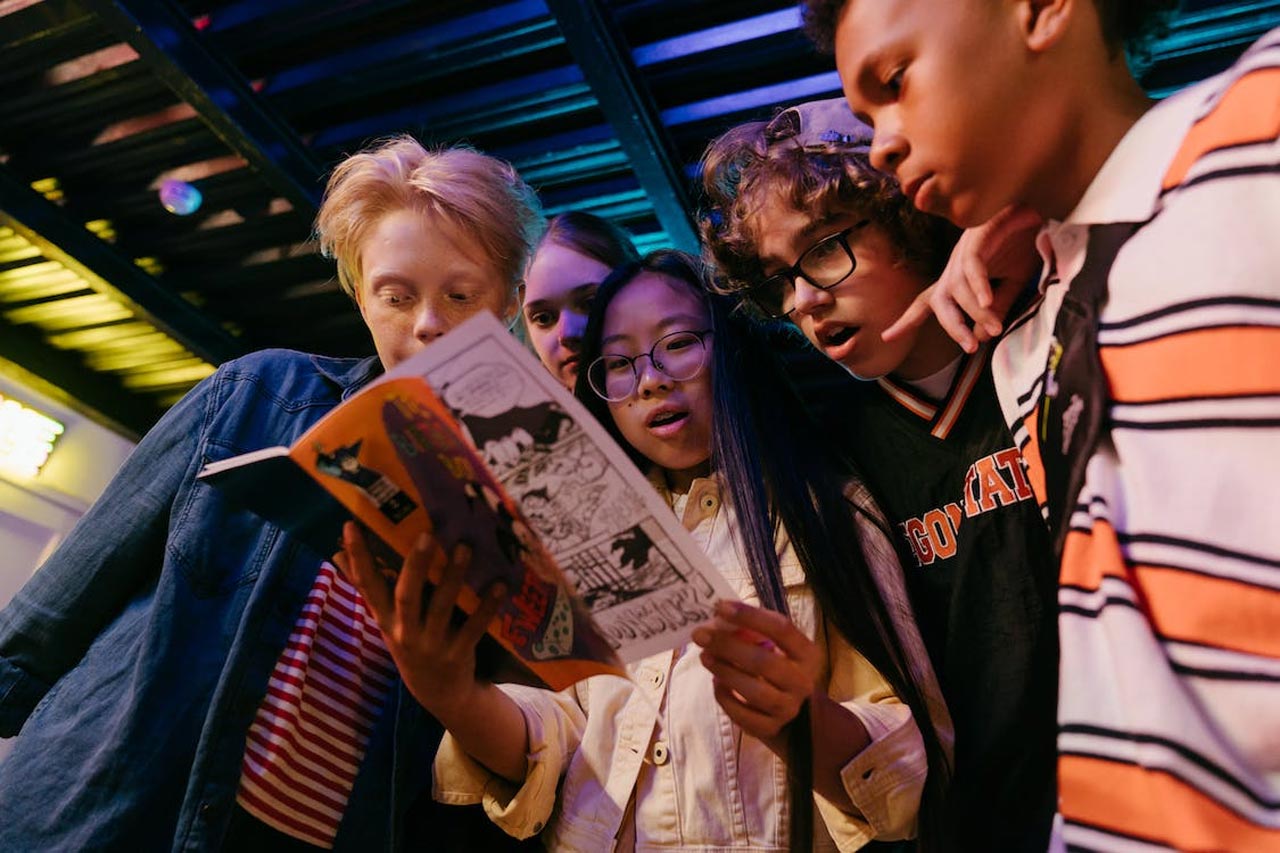
Image by Tania Van den Berghen from Pixabay
Sequential art (coined by Will Eisner in 1985), which includes comics, have been a source of entertainment and inspiration for generations, capturing the imaginations of readers with their vivid illustrations and captivating storylines. From classic heroes like Superman and Batman to the more recent explosion of webcomics, graphic novels, and manga, comics have evolved into a powerful form of expression that can explore a wide range of topics and genres.
Beyond their entertainment value, comics have also emerged as a valuable tool for mental health. Through their unique combination of visuals and text, comics can provide a powerful means of expressing emotions, sharing experiences, and promoting empathy and understanding. Comics offer a promising avenue for mental health treatment by fostering connections between individuals and by facilitating healing and support. While there may be some obstacles in the way of using comics for mental health, there are ways to get around them and make the most of this cutting-edge form of storytelling.
Understanding Mental Health
Mental health is an essential aspect of overall well-being that encompasses emotional and psychological factors that impact our ability to manage stress, maintain relationships, and make positive decisions (U.S. Department of Health & Human Services, 2021). Unfortunately, mental health issues are prevalent in the United States, affecting approximately 25% of the population (National Alliance on Mental Illness, 2022). Commonly diagnosed mental health conditions include anxiety and depression, as well as bipolar disorder, addiction, eating disorders, and PTSD (World Health Organization, 2021).

There are several risk factors that can contribute to the development of mental health issues, including genetics, brain chemistry, trauma, stress, exposure to violence, poverty, discrimination, and lack of access to quality healthcare (Ohrnberger et al., 2017).
Symptoms of mental health conditions can manifest in various ways, including changes in mood, behavior, or thought patterns and physical symptoms such as headaches, stomachaches, or fatigue (Substance Abuse and Mental Health Services Administration, 2021). Early intervention and treatment can significantly improve a person’s recovery and quality of life (Office of the Surgeon General, 2016).
Efforts to reduce the stigma surrounding mental health issues and to promote access to effective treatments and support services have been increasing in recent years. For example, one approach gaining traction in mental health treatment is the use of visual storytelling and imagery in sequential art. This approach can provide a safe space for individuals to explore and process their emotions (Czerwiec et al., 2015). Sequential art can offer readers a new way of thinking about mental health and foster empathy and understanding (Pollard, 2022).
The Power of Sequential Art
From ancient hieroglyphs to modern-day graphic novels, sequential art has been used to tell stories and evoke emotion through a combination of images and words. Sequential art encompasses many different forms and styles, including comics and graphic novels, and it has been found to have numerous positive effects on mental health.
Scott McCloud suggests in his book Understanding Comics that reading comics can have a positive impact on mental health. He states that comics can help with reducing stress, improving memory, and managing trauma or grief. This highlights the potential benefits of comics in promoting mental well-being, which can be further explored through research and practical applications. Moreover, comics can foster connections and conversations among readers.
Creating sequential art can also be a therapeutic tool for mental health, allowing individuals to express themselves creatively and explore their thoughts and feelings in a safe and supportive environment. It can help individuals gain a sense of control over their experiences and emotions, particularly for those who have difficulty expressing themselves verbally or have experienced trauma.
Sequential art therapy is a versatile and accessible tool that can be adapted for individuals of all ages and abilities. While it can be effective independently, it is often used as part of a comprehensive treatment plan that includes medication, talk therapy, and other therapeutic interventions. The benefits of incorporating sequential art into therapy are multifaceted, such as the following:
Catharsis
Catharsis, an essential concept in psychology, refers to the release of emotions that can occur when one engages with art, including sequential art such as comics. This can provide a powerful outlet for people to process and cope with difficult experiences, allowing them to move toward healing and resolution. The process of engaging with comics can help individuals express and understand their emotions in a safe space, providing a sense of validation and catharsis that can be difficult to find elsewhere.
Empathy
By exploring different perspectives and characters, comics provide an opportunity to gain insights into the thoughts and feelings of others. Through this, readers can better understand the experiences of people from different backgrounds, cultures, and identities, creating a sense of shared humanity. This can lead to increased empathy and acceptance of others, which can have a positive impact on their relationships and overall mental health.
Sense of community
Comics can also serve as a tool to create a sense of community among readers. Through the discussion of comics, individuals can come together to share their experiences and perspectives. This can foster meaningful connections between people and help build a more inclusive environment. This is especially beneficial for readers who may feel isolated or lonely, as it provides a space for them to connect with others who share similar interests and experiences.
Escapism
Readers can take a break from their daily routines by immersing themselves in new worlds and situations in comic books. They can find a positive distraction from negative thoughts and feelings, providing a brief respite from their worries and concerns. This can be a powerful tool for self-care and stress relief, allowing readers to explore their emotions in a safe and creative space.
Cognitive stimulation
Reading comics can also have cognitive benefits, as the combination of visuals and text can provide a stimulating experience for readers. This can help increase reading comprehension and expand critical thinking skills.
Encouragement of creativity
The imaginative and visually engaging storytelling techniques used in comics can spark readers’ creative ideas and encourage them to explore their creativity. Additionally, comics can inspire readers to think outside the box and approach problems or challenges in new and creative ways.
Comic Therapy
Comic therapy is a unique and innovative approach to therapy that harnesses the power of comics to explore and process complex emotional issues (Mulholland, 2004). Through a combination of drawings, text, and speech, clients are empowered to create their own stories, providing a safe and non-judgmental environment for self-expression. This approach can offer a refreshing alternative to traditional talk therapy, enabling clients to engage with their emotions in a more creative way.
One of the key benefits of comic therapy is its versatility in addressing a range of emotional topics. Whether it’s exploring family dynamics and relationships or coping with grief and trauma, comics provide an effective medium for clients to explore their thoughts and feelings. By engaging with the creative process of comics, clients can gain deeper insights into their own emotional experiences and perspectives, leading to greater self-awareness and emotional resilience.
Moreover, comic therapy allows therapists to gain a unique and nuanced understanding of their clients’ emotional states. The combination of text and visuals in comics can offer rich insights into clients’ experiences and feelings, enabling therapists to provide more targeted and effective support.

The success stories of comic therapy are inspiring and encouraging, offering hope and insights into the transformative power of creative expression. From individuals coping with trauma and anxiety to those seeking greater self-awareness and personal growth, the therapeutic benefits of comics have touched the lives of many.
According to a study, comic therapy can help children with sickle cell disease manage their pain and improve their emotional and physical well-being (Broome et al., 2001).
A clinical trial that enrolled 47 women aged 18–65 years, all of whom had been diagnosed with either generalized anxiety disorder, social anxiety disorder, or panic disorder and were experiencing moderate to severe anxiety symptoms, showed the effectiveness of art therapy in reducing anxiety as well as a significant improvement in subjective quality of life, indicating a large effect size, as well as an improvement in the accessibility of emotion regulation strategies, indicating a medium effect size (Abbing et al., 2019).
Art therapy has become an important component of PTSD treatment for combat veterans. The combination of art therapy and cognitive processing therapy (CPT) has been found to be more effective in reducing symptoms of combat-related posttraumatic stress disorder (PTSD) than CPT alone. Veterans of war find that this method is more effective at fostering healthy distance, enhancing trauma recall, and facilitating access to emotions (Campbell et al., 2016).
These success stories demonstrate the potential for comic therapy to facilitate meaningful emotional growth and healing. By providing a safe and creative outlet for individuals to explore their thoughts and feelings, comics can serve as a powerful tool for mental health treatment.
Representation and Diversity in Comics

Photo by cottonbro studio from Pexels
Representation and diversity in comics play a critical role in promoting inclusivity and fostering a sense of belonging, particularly for historically marginalized groups. By showcasing diverse characters and storylines, comics have the potential to promote positive social norms, break down stereotypes, and improve self-esteem and feelings of isolation. Furthermore, diverse representation in comics can have a significant positive impact on mental health by providing readers with a sense of validation and acceptance. When readers see characters that reflect their own experiences and identities, they feel seen, heard, and understood, which can lead to a greater sense of well-being and happiness. Diversity in comics is more important than ever, as comics possess the ability to unite people and promote a society that is more accepting and inclusive.
Despite progress, there is still a need for more inclusive and representative content in comics. This means not only featuring characters with different backgrounds but also ensuring that they are portrayed accurately and positively. It is also essential to have diverse creators involved in the creation of comics, as they can bring their unique perspectives and experiences to the table.
Representation in comics can provide readers with an opportunity to explore diverse identities and perspectives, fostering empathy and understanding. Through the portrayal of characters from varied backgrounds and experiences, readers can broaden their understanding of the world around them, leading to increased empathy and acceptance of others. This shift in perspective has the potential to positively impact readers’ relationships as they learn to appreciate the richness and complexity of human experiences, which are essential for creating a more equitable and harmonious society.
To illustrate this point, several comics and graphic novels with diverse representations have emerged in recent years. Here are some examples:
Ms. Marvel by Marvel Comics
Ms. Marvel’s strong Muslim female characters and their relationships offer a compelling and authentic representation of cultural diversity. Kamala Khan, the protagonist and Ms. Marvel’s alter ego, resonates with audiences by portraying an authentic and nuanced immigrant experience in America. The series presents relatable and realistic depictions of the challenges faced by diverse American immigrants, such as students, geeks, and those from religious families, as they navigate complex cultural intricacies. Through empathy and authenticity, Ms. Marvel serves as a powerful example of the importance of representation and diversity in media, promoting understanding and acceptance of different cultures and experiences. The Marvel Comics series highlights the crucial role that media can play in fostering a more inclusive and accepting society.
Heartstopper by Alice Oseman
Since being adapted into a Netflix series, this popular webcomic has gained even more attention. The story is not simply about a romance between two boys, but rather reflects the ideals of queer literature, with depth and complexity that go beyond mere inclusivity. Through her nuanced and authentic portrayal of queer characters, Oseman’s work offers a powerful message of acceptance and representation, showing that queer characters are not defined by their sexuality but are complex and multifaceted individuals who deserve to have their stories told.
Bunker by DC Comics
Bunker, a superhero of Mexican American descent and a member of the Teen Titans, can generate psionic bricks out of thin air to create walls or structures. He can create force fields and manipulate sound waves, and he is openly gay, representing the LGBTQ+ community positively in superhero comics. Created by Scott Lobdell and Brett Booth, Bunker’s real name is Miguel Barragan, and he first appeared in Teen Titans in 2011. He has a lively personality and sense of humor, which have made him a popular character among fans of the Teen Titans series, and he has also appeared in other DC Comics titles such as Red Hood and the Outlaws and Justice League Odyssey.
El Deafo by Cece Bell
El Deafo is a semi-autobiographical graphic novel written and illustrated by Cece Bell, who lost her hearing at a young age. The book features anthropomorphic bunny characters and tells the story of Cece’s childhood experiences with deafness, exploring themes such as identity, friendship, and fitting in. The main character, also named Cece, is portrayed as a superhero named El Deafo, who uses her hearing aid to hear sounds that others cannot. The book has been highly praised for its positive representation of disability and its engaging storytelling. It has won several awards and has been used in schools and libraries to promote empathy and understanding of disability.
Representation and diversity in comics are critical topics that have gained increasing attention in recent years. The lack of diversity in comics has been a longstanding issue, with many individuals feeling excluded and underrepresented in the industry. However, with the emergence of new voices and perspectives, there has been a gradual shift toward inclusivity and representation. While there is still a long way to go, the progress that has been made in recent years is promising. As more and more people demand diverse representation in comics, the industry is slowly but surely beginning to respond. It is vital that this momentum continues and that creators and publishers remain committed to ensuring that comics reflect the diversity of our world.
The Future of Comics in Mental Health
The field of comic therapy is rapidly expanding, and there is enormous potential for its growth in the mental health field. As research continues to explore the effects of comic therapy, it can offer valuable insights into how comics can be used to address a wide range of mental health issues. Moreover, as the use of comic therapy becomes more widely accepted, it is possible that more mental health practitioners will incorporate it into their practice. This could potentially lead to the creation of more diverse and inclusive comics that cater to the needs of a broader audience.
Collaborations between comic creators and mental health professionals offer exciting opportunities for the field of comic therapy (Wahowiak, 2014). Mental health professionals can provide their expertise to explore different topics, while comic creators can use their artistic skills to create engaging and meaningful stories. This collaboration could lead to the development of more inclusive and relevant comics that address a variety of mental health issues. It may also provide a safe and supportive space for readers to explore complex issues and gain a deeper understanding of their experiences.
While comic therapy has great potential, it is important to acknowledge and address these challenges and limitations. To make comics more accessible, therapists can provide guidance and support to clients who are new to creating or reading comics. They can also offer alternative forms of expression, such as journaling or verbal communication, for clients who do not feel comfortable with comics.
To address concerns about the suitability of comics for certain mental health issues, therapists can consider using comics in conjunction with other therapeutic approaches, such as talk therapy or medication. This can help ensure that clients receive a comprehensive and effective treatment plan.
Regarding ethical considerations, therapists can work with comic creators to ensure that the stories they use in therapy are appropriate and respectful of clients from diverse backgrounds. They can also provide trigger warnings and offer resources for clients who may be affected by the content of the comics.
Healing through Comics
Sequential art has great potential in the field of mental health, and its use in therapy, also known as comic therapy, is a promising avenue for healing. Through comic therapy, individuals can express themselves, process complex emotions, and gain a deeper understanding of their experiences in a safe and supportive environment.
Collaborations between comic creators and mental health professionals offer exciting opportunities to create more inclusive and relevant stories that address a wide range of mental health issues. While comic therapy is not a panacea, it has enormous potential to complement and enhance other therapeutic approaches.
As the use of comics in mental health continues to grow, it is essential that creators and practitioners remain committed to ensuring that comics are accessible, respectful, and suitable for a diverse range of individuals. With continued research and the expansion of comic therapy, more individuals can benefit from this unique and powerful form of expression and storytelling.
References
Abbing, A., Baars, E. W., de Sonneville, L., Ponstein, A. S., & Swaab, H. (2019). The effectiveness of art therapy for anxiety in adult women: A randomized controlled trial. Frontiers in Psychology, 10, 1203. https://doi.org/10.3389/fpsyg.2019.01203
Bell, C. (2014). El Deafo. Abrams Books/Amulet. https://www.abramsbooks.com/product/el-deafo_9781419712173/
Broome, M. E., Maikler, V., Kelber, S., Bailey, P., & Lea, G. (2001). An intervention to increase coping and reduce health care utilization for school-age children and adolescents with sickle cell disease. Journal of National Black Nurses’ Association: JNBNA, 12(2), 6–14. https://europepmc.org/article/med/11902023
Campbell, M., Decker, K. P., Kruk, K., & Deaver, S. P. (2016). Art therapy and cognitive processing therapy for combat-related PTSD: A randomized controlled trial. Art Therapy: Journal of the American Art Therapy Association, 33(4), 169–177. https://doi.org/10.1080/07421656.2016.1226643
Cocca, C. (2016). “Introduction: Representation Matters.” In Superwomen: Gender, Power, and Representation (p. 1). Bloomsbury Publishing Inc. https://doi.org/10.5040/9781501316609
Czerwiec, M. K., Williams, I., Squier, S. M., Green, M. J., Myers, K. R., & Smith, S. T. (2015). Graphic Medicine Manifesto. Pennsylvania State University Press. https://www.psupress.org/books/titles/978-0-271-06649-3.html
Eisner, W. (1985). Comics & sequential art (1st ed.). Poorhouse Press. Retrieved from https://www.google.com/books/edition/_/ZBgRAQAAMAAJ?hl=en&kptab=overview
Kessler, R. C., Amminger, G. P., Aguilar-Gaxiola, S., Alonso, J., Lee, S., & Üstün, T. B. (2007). Age of onset of mental disorders: a review of recent literature. Current Opinion in Psychiatry, 20(4), 359–364. https://doi.org/10.1097/yco.0b013e32816ebc8c
Miguel Barragan (Prime Earth). DC Database. https://dc.fandom.com/wiki/Miguel_Barragan_(Prime_Earth)
Ms. Marvel (Kamala Khan) In Comics Powers, Enemies, History | Marvel. (2018). Marvel Entertainment. https://www.marvel.com/characters/ms-marvel-kamala-khan/in-comics
Mulholland, M. J. (2004). Comics as Art Therapy. Art Therapy: Journal of the American Art Therapy Association, 21(1), 42–43. https://doi.org/10.1080/07421656.2004.10129317
National Alliance on Mental Illness. Mental Health By the Numbers. https://www.nami.org/mhstats.
Office of the Surgeon General. (2016). Facing Addiction in America: The Surgeon General’s Report on Alcohol, Drugs, and Health. “Early Intervention, Treatment, and Management of Substance Use Disorders.” US Department of Health and Human Services. https://addiction.surgeongeneral.gov/executive-summary/report/early-intervention-treatment-and-management-substance-use-disorders
Ohrnberger, J., Fichera, E., & Sutton, M. (2017). The relationship between physical and mental health: A mediation analysis. Social Science & Medicine, 195, 42–49. https://doi.org/10.1016/j.socscimed.2017.11.008
Oseman, A. (2019). Heartstopper. Hachette Children’s Group. https://aliceoseman.com/heartstopper/graphic-novels/
Pollard, J. A. (2022). Comics in clinical practice: a grounded theory exploration of how sequential art is applied to talking therapy. Middlesex University / Metanoia Institute.
Shwed, A. (2016). Crisis averted in infinite lives: Utilizing comics as clinical art therapy. Intima: A Journal of Narrative Medicine. https://www.theintima.org/s/Crisis-Averted-FA16-FINAL.pdf
U.S. Department of Health & Human Services. (2021, March 10). “What is mental health?” MentalHealth.gov. https://www.mentalhealth.gov/basics/what-is-mental-health
Wahowiak, L. (2014). Health workers, artists partner to deliver messages via comics: Tools can influence health behavior. The Nation’s Health, 44(7), 1–16. http://www.thenationshealth.org/content/44/7/1.1.abstract
Warning Signs and Risk Factors for Emotional Distress. (2015). https://www.samhsa.gov/find-help/disaster-distress-helpline/warning-signs-risk-factors
World Health Organization. (2021). Mental disorders. Retrieved from https://www.who.int/news-room/fact-sheets/detail/mental-disorders



